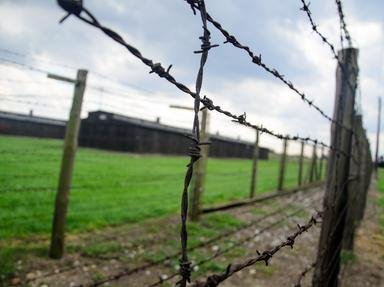Quiz Answer Key and Fun Facts
1. The expression "the Holocaust" for the Nazi genocide of the Jews has largely replaced an earlier term. What was it?
2. Until c. 1960 or later it was widely taken for granted that Hitler had planned the Holocaust early in his political career and had a master plan in place by 1925. What is the strongest evidence *against* this assumption?
3. On the eve of World War II which European country had the largest Jewish population (August 1939 borders)?
4. Between October 1939 and February 1940 about 95,000 Jews were deported from Moravia, Vienna and Pomerania to a 'Jewish reservation', set up by Eichmann and other SS officers. Where was it?
5. On 15 October 1941 the first trainload of Jews left Berlin, bound for Eastern Europe. Some were dumped in the already overcrowded Lodz Ghetto. Where were most of the others taken to?
6. In October 1939 the Nazis began forcing Jews in Poland to live in ghettos. Which of these ghettos lasted longest? (Hints: 1. It's NOT the best known ghetto. 2. It was in an industrial city and therefore most useful to the Nazis).
7. When did the mobile killing units (SD-Einsatzgruppen) first go into action in Operation Barbarossa, and where?
8. Routine mass gassings of Jews began on 8 December 1941 using specially designed vans. Where?
9. In December 1941 an early report of the Holocaust reached the Foreign Office in London. The official who read it wrote a comment in the margin. What was it?
10. In the case of one extermination camp, the SS's own figure for the total number of Jews killed there is known. Which camp is it?
11. Holocaust scholars distinguish between extermination camps and concentration camps. What made the extermination camps different?
12. One of these survivors was awarded the Nobel Peace Prize in 1986. Who was it?
13. Some camps had brass ensembles or even orchestras. Which of these camps had a women's orchestra of about forty?
14. In October 1943 there was an uprising and mass breakout at Sobibor led by Alexander Pechersky and Leon Feldhendler. Pechersky lived till 1990. What happened to Leon Feldhendler?
15. Did the Allies do anything specifically designed to prevent or halt the Holocaust, other than winning the war?
Source: Author
bloomsby
This quiz was reviewed by FunTrivia editor
Exit10 before going online.
Any errors found in FunTrivia content are routinely corrected through our feedback system.

